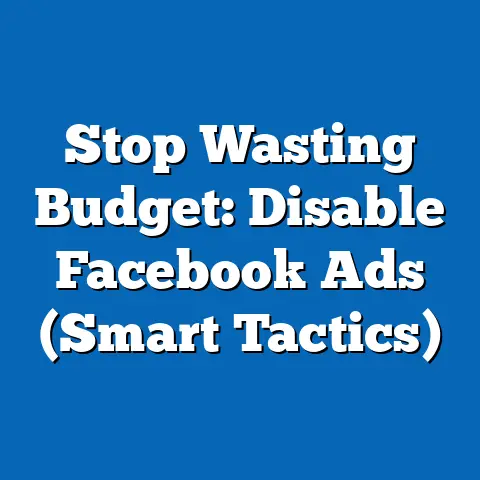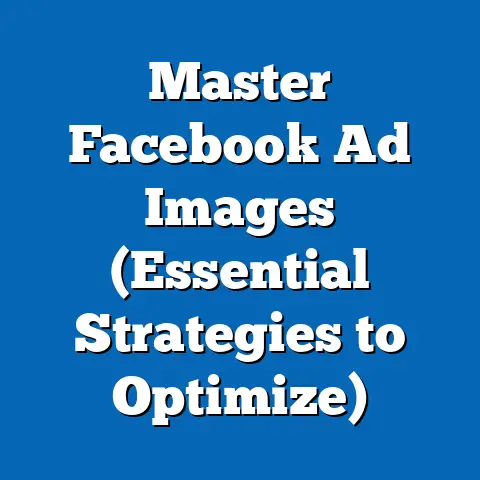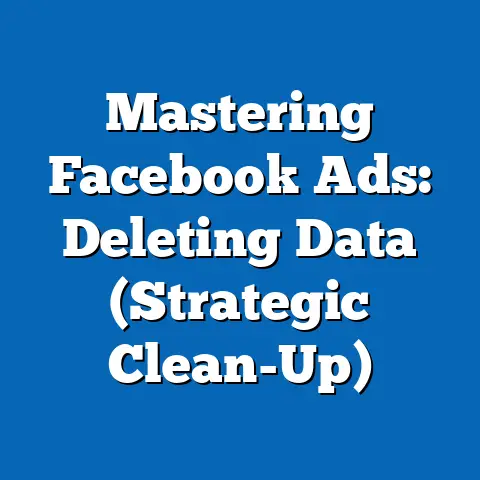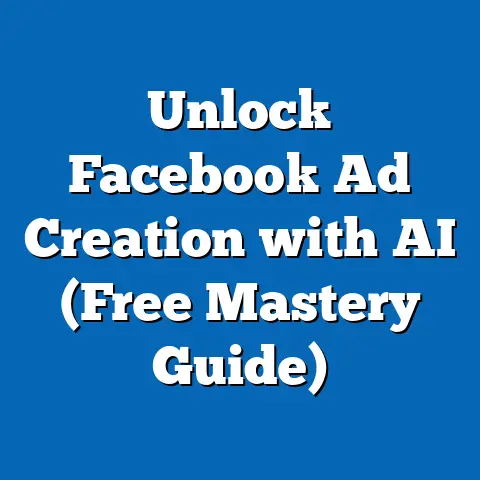Google vs Facebook Ad Revenue: Who Wins? (Revenue Showdown)
Do you remember the days of dial-up internet and the excitement of seeing your first banner ad? I do. Back then, the online advertising landscape was a wild west, full of experimentation and uncertainty. Giants like Google and Facebook were just beginning to flex their muscles, laying the groundwork for the targeted advertising we see today. Google’s AdWords, launched in 2000, revolutionized search engine marketing, while Facebook’s advertising platform, introduced in 2007, tapped into the power of social connections.
These two behemoths have since transformed how businesses reach their customers, but a question remains: Who truly dominates the ad revenue game? In this ongoing rivalry, we’ll dive deep into the numbers, strategies, and future prospects of both Google and Facebook to determine who comes out on top in the ad revenue showdown.
Overview of Google Ad Revenue
Google’s journey in advertising started with a simple yet powerful idea: connecting advertisers with users actively searching for information. AdWords, later rebranded as Google Ads, was the vehicle that drove this revolution. By allowing businesses to bid on keywords, Google created an auction-based system that rewarded relevance and quality.
One of Google’s greatest strengths lies in search-based advertising. When someone types a query into Google, they’re actively seeking an answer or a solution. This intent-driven nature of search queries makes Google Ads incredibly effective. Advertisers can target specific keywords, ensuring their ads appear in front of users who are most likely to be interested in their products or services.
The numbers speak for themselves. Google consistently dominates the search engine market, capturing a massive share of ad revenue. In 2023, Google’s ad revenue reached an astounding $282.7 billion. This growth isn’t just about search; Google has diversified its ad offerings to include display ads, shopping ads, and video ads via YouTube.
YouTube, in particular, has become a significant revenue driver. With billions of users watching videos every month, YouTube provides advertisers with a vast audience and a variety of ad formats, from skippable in-stream ads to non-skippable bumper ads.
Key Takeaway: Google’s strength lies in its search dominance and intent-based advertising model, making it a powerhouse in the digital advertising landscape.
Overview of Facebook Ad Revenue
Facebook’s entry into the advertising world was a bit different. Instead of focusing on search intent, Facebook leveraged its vast trove of user data to create highly targeted social media ads. From its inception, Facebook allowed users to share their interests, demographics, and behaviors, providing advertisers with a treasure trove of information.
The platform’s strength lies in its unparalleled audience targeting capabilities. Advertisers can target users based on everything from their age and location to their hobbies and purchase history. This level of granularity allows businesses to create hyper-targeted campaigns that resonate with specific segments of their audience.
Like Google, Facebook has seen impressive growth in ad revenue. In 2023, Meta (Facebook’s parent company) reported ad revenue of $134.9 billion. While this is significantly less than Google, Facebook still commands a massive share of the social media advertising market.
Facebook offers a variety of ad formats, including image ads, video ads, carousel ads, and collection ads. These formats are designed to capture users’ attention as they scroll through their newsfeeds, making them ideal for brand awareness and engagement campaigns. Instagram, also owned by Meta, further enhances Facebook’s advertising reach. With its visually-driven platform, Instagram is particularly effective for reaching younger audiences and promoting visually appealing products.
Key Takeaway: Facebook’s strength lies in its social media dominance and unparalleled audience targeting capabilities, making it a go-to platform for brand awareness and engagement.
Comparative Analysis of Revenue Models
Now, let’s dive into a direct comparison of the revenue models of Google and Facebook. Google’s auction-based system for search ads is all about relevance and quality. Advertisers bid on keywords, and Google’s algorithm determines which ads to show based on factors like bid amount, ad quality, and expected click-through rate. This system rewards advertisers who create compelling ads that are relevant to users’ search queries.
Facebook, on the other hand, uses a bidding system for social ads that takes into account factors like audience targeting, ad placement, and ad quality. Advertisers can set their own budgets and bid amounts, and Facebook’s algorithm optimizes ad delivery to maximize results.
So, which platform is more effective for advertisers? It depends on their goals. Google Ads is often more effective for driving immediate conversions, as users are actively searching for products or services. Facebook Ads, on the other hand, is often more effective for building brand awareness and driving engagement, as it allows advertisers to reach a broad audience with visually appealing ads.
I’ve seen firsthand how different businesses thrive on each platform. E-commerce brands often find success with Google Shopping ads, which allow them to showcase their products directly in search results. Local businesses, on the other hand, often leverage Facebook’s geo-targeting capabilities to reach customers in their area.
Key Takeaway: Google’s auction-based system focuses on relevance and quality, while Facebook’s bidding system prioritizes audience targeting and engagement.
Market Trends and Future Projections
The digital advertising landscape is constantly evolving, and both Google and Facebook are facing new challenges and opportunities. One of the biggest trends is the shift towards privacy-centric advertising. As users become more concerned about their data, platforms like Apple are introducing new privacy features that limit the ability of advertisers to track users across the web.
This shift is forcing Google and Facebook to rethink their advertising strategies. Both companies are investing in new technologies and strategies that allow them to deliver personalized ads without relying on third-party cookies. Artificial intelligence (AI) and machine learning (ML) are playing a key role in this transition.
Google is using AI to improve ad targeting and optimize ad delivery, while Facebook is using AI to enhance ad creative and personalize user experiences. For example, Google’s Performance Max campaigns use AI to automatically optimize ad campaigns across all of Google’s channels, while Facebook’s Advantage+ creative uses AI to generate ad variations that are tailored to individual users.
Looking ahead, experts predict continued growth in digital advertising, but the pace of growth may slow down as the market becomes more saturated. Competition from emerging platforms like TikTok and Snapchat is also intensifying. TikTok, in particular, has seen rapid growth in ad revenue, thanks to its highly engaged user base and unique video format.
According to eMarketer, digital ad spending is expected to reach $626.59 billion worldwide in 2024. While Google and Facebook will continue to dominate the market, they will need to adapt to changing user behavior and emerging technologies to maintain their competitive edge.
Key Takeaway: Privacy-centric advertising, AI, and competition from emerging platforms are key trends shaping the future of digital advertising.
Conclusion
So, who wins the ad revenue showdown? While Google consistently generates more ad revenue overall, Facebook remains a dominant force in social media advertising. Both platforms offer unique strengths and opportunities for advertisers, and the best choice depends on their specific goals and target audience.
Google’s search dominance and intent-based advertising model make it ideal for driving immediate conversions, while Facebook’s social media reach and unparalleled audience targeting capabilities make it perfect for building brand awareness and driving engagement.
As the digital advertising landscape continues to evolve, both Google and Facebook will need to adapt and innovate to stay ahead of the curve. The rise of privacy-centric advertising, the growing importance of AI, and the increasing competition from emerging platforms will all play a role in shaping the future of advertising.
Ultimately, the competition between Google and Facebook benefits advertisers, as it drives innovation and forces both companies to deliver better results. Whether this competition will evolve or if a new contender will emerge remains to be seen, but one thing is certain: the future of advertising is bright.
Final Thought: When choosing between Google and Facebook for your advertising needs, consider your goals, target audience, and budget. Experiment with both platforms to see which one delivers the best results for your business.
(Optional) Call to Action:
I’d love to hear about your experiences with Google and Facebook advertising. Share your thoughts and insights in the comments below or on social media!






